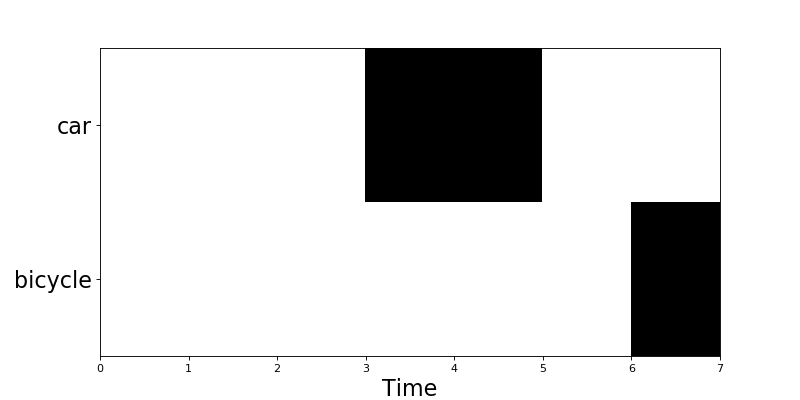Processing chain
In addition to the basic utilities, the library provides mechanism to link various data processing classes together.
This allows easier construction of complex data processing pipelines. The data processing is done in processors,
which are contained in the processing chain (a list of processors).
All processors classes are inherited from dcase_util.processors.Processor.
Audio related processors:
dcase_util.processors.AudioReadingProcessor, audio reading, supports multi-channel audio.dcase_util.processors.AudioWritingProcessor, audio writing, supports multi-channel audio.dcase_util.processors.MonoAudioReadingProcessor, audio reading, in case of multi-channel audio channels will be mixed down into single channel.dcase_util.processors.MonoAudioWritingProcessor, audio writing, in case of multi-channel audio channels will be mixed down into single channel.
Data manipulation processors:
dcase_util.processors.AggregationProcessor, aggregating data withing sliding processing window.dcase_util.processors.RepositoryAggregationProcessor, aggregating data stored in the data repository.dcase_util.processors.SequencingProcessor, splitting data matrix into sequences.dcase_util.processors.RepositorySequencingProcessor, splitting data stored in the data repository.dcase_util.processors.NormalizationProcessor, normalizing data matrix.dcase_util.processors.RepositoryNormalizationProcessor, normalizing data stored in the data repository.dcase_util.processors.StackingProcessor, stack a new feature matrix based on data stored inside a repository.dcase_util.processors.RepositoryMaskingProcessor, masking data stored in the data repository.dcase_util.processors.DataShapingProcessor, reshaping data stored in the data container.dcase_util.processors.RepositoryToMatrixProcessor, converting data from data repository into a single matrix.
Data encoding processors:
dcase_util.processors.OneHotEncodingProcessor, one-hot encoding (classification).dcase_util.processors.ManyHotEncodingProcessor, many-hot encoding (tagging).dcase_util.processors.EventRollEncodingProcessor, event roll encoding (detection).
Feature extraction processors:
dcase_util.processors.FeatureReadingProcessor, reading features from a file.dcase_util.processors.FeatureWritingProcessor, writing features into a file.dcase_util.processors.RepositoryFeatureReadingProcessor, reading features from a file and storing them in the data repository.dcase_util.processors.RepositoryFeatureWritingProcessor, writing feature repository into a file.dcase_util.processors.FeatureExtractorProcessor, extracting features.dcase_util.processors.RepositoryFeatureExtractorProcessor, extracting many feature types at the same time, and storing them into single repository. Supports multi-channel audio input.dcase_util.processors.MelExtractorProcessor, extracting mel-band energies. Supports only single channel audio.dcase_util.processors.MfccStaticExtractorProcessor, extracting static MFCCs. Supports only single channel audio.dcase_util.processors.MfccDeltaExtractorProcessor, extracting delta MFCCs. Supports only single channel audio.dcase_util.processors.MfccAccelerationExtractorProcessor, extracting acceleration MFCCs. Supports only single channel audio.dcase_util.processors.ZeroCrossingRateExtractorProcessor, extracting zero-crossing rate. Supports only single channel audio.dcase_util.processors.RMSEnergyExtractorProcessor, extracting RMS energies. Supports only single channel audio.dcase_util.processors.SpectralCentroidExtractorProcessor, extracting Spectral centroid. Supports only single channel audio.
Meta data processors:
dcase_util.processors.MetadataReadingProcessor, meta data reading from a file.
Feature extraction and processing
Extracting mel-band energies for an audio file:
# Define processing chain
chain = dcase_util.processors.ProcessingChain([
{
'processor_name': 'MonoAudioReadingProcessor',
'init_parameters': {
'fs': 44100
}
},
{
'processor_name': 'MelExtractorProcessor'
}
])
# Run the processing chain
data = chain.process(filename=dcase_util.utils.Example().audio_filename())
data.show()
# FeatureContainer :: Class
# Data
# data : matrix (40,501)
# Dimensions
# time_axis : 1
# Timing information
# time_resolution : 0.02 sec
# Meta
# stats : Calculated
# metadata : -
# processing_chain : -
# Duration
# Frames : 501
# Seconds : 10.02 sec
# Data
# Dimensions
# time_axis : 1
# data_axis : 0
data.plot()
(Source code, png, hires.png, pdf)
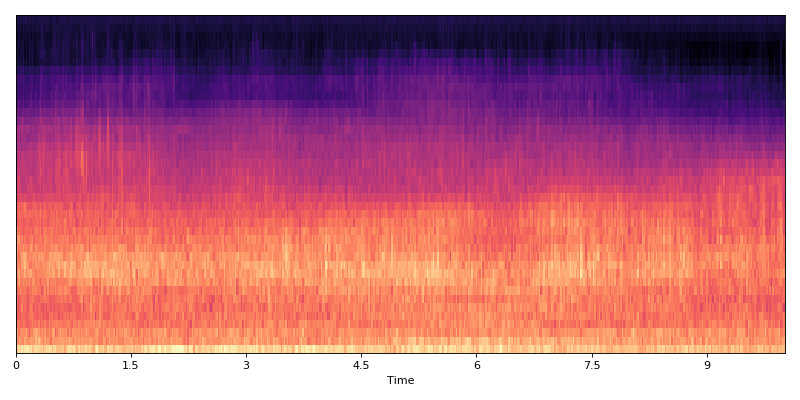
Focusing on certain part of audio:
# Define processing chain
chain = dcase_util.processors.ProcessingChain([
{
'processor_name': 'MonoAudioReadingProcessor',
'init_parameters': {
'fs': 44100
}
},
{
'processor_name': 'MelExtractorProcessor'
}
])
# Run the processing chain
data = chain.process(
filename=dcase_util.utils.Example().audio_filename(),
focus_start_seconds=1.0,
focus_duration_seconds=2.0
)
print(data.shape)
# (40, 101)
# Run the processing chain
data = chain.process(
filename=dcase_util.utils.Example().audio_filename(),
focus_start_samples=44100,
focus_stop_samples=44100*2
)
print(data.shape)
# (40, 51)
Extracting a few different acoustic features for an audio file, and form data matrix:
# Define processing chain
chain = dcase_util.processors.ProcessingChain([
{
'processor_name': 'MonoAudioReadingProcessor',
'init_parameters': {
'fs': 44100
}
},
{
'processor_name': 'RepositoryFeatureExtractorProcessor',
'init_parameters': {
'parameters': {
'mel': {},
'mfcc': {}
}
}
},
{
'processor_name': 'StackingProcessor',
'init_parameters': {
'recipe': 'mel;mfcc=1-19'
}
}
])
# Run the processing chain
data = chain.process(filename=dcase_util.utils.Example().audio_filename())
data.show()
data.plot()
(Source code, png, hires.png, pdf)
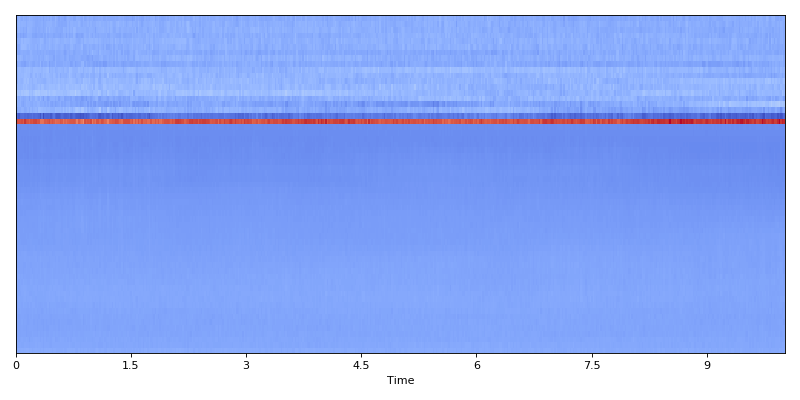
Extracting a few different acoustic features for an audio file, normalize them, form data matrix, aggregate along time axis (context windowing), and split data into sequences:
import numpy
# Normalization factors
mel_mean = numpy.array([
-3.26094211, -4.20447522, -4.57860912, -5.11036974, -5.33019526,
-5.48390484, -5.50473626, -5.54014946, -5.28249358, -5.12090705,
-5.21508926, -5.3824216, -5.37758142, -5.38829567, -5.4912112,
-5.55352419, -5.72801733, -6.02412347, -6.41367833, -6.64073975,
-6.80493457, -6.8717373, -6.88140949, -6.91464104, -7.00929399,
-7.13497673, -7.36417664, -7.73457445, -8.25007518, -8.79878143,
-9.22709866, -9.28843908, -9.57054527, -9.82846299, -9.85425306,
-9.90253041, -9.85194976, -9.62786338, -9.38480217, -9.18478766
])
mel_std = numpy.array([
0.3450398, 0.47330394, 0.53112192, 0.57607313, 0.66710664,
0.70052532, 0.79045046, 0.81864229, 0.79422025, 0.76691708,
0.64798516, 0.59340713, 0.57756029, 0.64032687, 0.70226395,
0.75670044, 0.80861907, 0.79305124, 0.7289238, 0.75346821,
0.77785602, 0.7350573, 0.75137917, 0.77171676, 0.80314121,
0.78965339, 0.79256442, 0.82524546, 0.84596991, 0.76430333,
0.69690919, 0.69591269, 0.54718615, 0.5277196, 0.61271734,
0.54482468, 0.42716334, 0.25561558, 0.08991936, 0.06402002
])
mfcc_mean = numpy.array([
-1.89603847e+02, 4.88930395e+01, -8.37911555e+00,
2.58522036e+00, 4.51964497e+00, -3.87312873e-01,
8.97250541e+00, 1.61597737e+00, 1.74111135e+00,
2.50223131e+00, 3.03385048e+00, 1.34561742e-01,
1.04119803e+00, -2.57486399e-01, 7.58245525e-01,
1.11375319e+00, 5.45536494e-01, 7.62699140e-01,
9.34355519e-01, 1.57158221e-01
])
mfcc_std = numpy.array([
15.94006483, 2.39593761, 4.78748908, 2.39555341,
2.66573364, 1.75496556, 2.75005027, 1.5436589,
1.81070379, 1.39476785, 1.22560606, 1.25575051,
1.34613239, 1.46778281, 1.19398649, 1.1590474,
1.1309816, 1.12975486, 0.95503429, 1.01747647
])
# Define processing chain
chain = dcase_util.processors.ProcessingChain([
{
'processor_name': 'MonoAudioReadingProcessor',
'init_parameters': {
'fs': 44100
}
},
{
'processor_name': 'RepositoryFeatureExtractorProcessor',
'init_parameters': {
'parameters': {
'mel': {},
'mfcc': {}
}
}
},
{
'processor_name': 'RepositoryNormalizationProcessor',
'init_parameters': {
'parameters': {
'mel': {
'mean': mel_mean,
'std': mel_std
},
'mfcc': {
'mean': mfcc_mean,
'std': mfcc_std
}
}
}
},
{
'processor_name': 'StackingProcessor',
'init_parameters': {
'recipe': 'mel;mfcc=1-19'
}
},
{
'processor_name': 'AggregationProcessor',
'init_parameters': {
'recipe': ['flatten'],
'win_length_frames': 5,
'hop_length_frames': 1,
}
},
{
'processor_name': 'SequencingProcessor',
'init_parameters': {
'sequence_length': 50
}
},
])
data = chain.process(filename=dcase_util.utils.Example().audio_filename())
data.show()
# DataMatrix3DContainer :: Class
# Data
# data : matrix (295,50,10)
# Dimensions
# time_axis : 1
# Timing information
# time_resolution : None
# Meta
# stats : Calculated
# metadata : -
# processing_chain : -
# Duration
# Frames : 50
# Data
# Dimensions
# time_axis : 1
# data_axis : 0
# sequence_axis : 2
data.plot()
(Source code, png, hires.png, pdf)
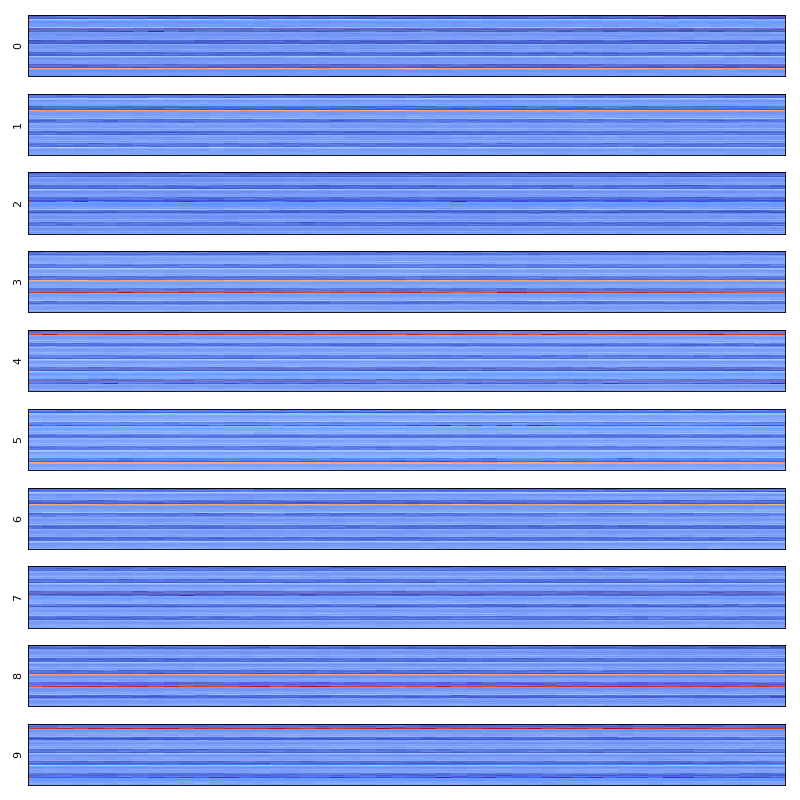
Reshaping output matrix:
import numpy
# Normalization factors
mel_mean = numpy.array([
-3.26094211, -4.20447522, -4.57860912, -5.11036974, -5.33019526,
-5.48390484, -5.50473626, -5.54014946, -5.28249358, -5.12090705,
-5.21508926, -5.3824216, -5.37758142, -5.38829567, -5.4912112,
-5.55352419, -5.72801733, -6.02412347, -6.41367833, -6.64073975,
-6.80493457, -6.8717373, -6.88140949, -6.91464104, -7.00929399,
-7.13497673, -7.36417664, -7.73457445, -8.25007518, -8.79878143,
-9.22709866, -9.28843908, -9.57054527, -9.82846299, -9.85425306,
-9.90253041, -9.85194976, -9.62786338, -9.38480217, -9.18478766
])
mel_std = numpy.array([
0.3450398, 0.47330394, 0.53112192, 0.57607313, 0.66710664,
0.70052532, 0.79045046, 0.81864229, 0.79422025, 0.76691708,
0.64798516, 0.59340713, 0.57756029, 0.64032687, 0.70226395,
0.75670044, 0.80861907, 0.79305124, 0.7289238, 0.75346821,
0.77785602, 0.7350573, 0.75137917, 0.77171676, 0.80314121,
0.78965339, 0.79256442, 0.82524546, 0.84596991, 0.76430333,
0.69690919, 0.69591269, 0.54718615, 0.5277196, 0.61271734,
0.54482468, 0.42716334, 0.25561558, 0.08991936, 0.06402002
])
mfcc_mean = numpy.array([
-1.89603847e+02, 4.88930395e+01, -8.37911555e+00,
2.58522036e+00, 4.51964497e+00, -3.87312873e-01,
8.97250541e+00, 1.61597737e+00, 1.74111135e+00,
2.50223131e+00, 3.03385048e+00, 1.34561742e-01,
1.04119803e+00, -2.57486399e-01, 7.58245525e-01,
1.11375319e+00, 5.45536494e-01, 7.62699140e-01,
9.34355519e-01, 1.57158221e-01
])
mfcc_std = numpy.array([
15.94006483, 2.39593761, 4.78748908, 2.39555341,
2.66573364, 1.75496556, 2.75005027, 1.5436589,
1.81070379, 1.39476785, 1.22560606, 1.25575051,
1.34613239, 1.46778281, 1.19398649, 1.1590474,
1.1309816, 1.12975486, 0.95503429, 1.01747647
])
# Define processing chain
chain = dcase_util.processors.ProcessingChain([
{
'processor_name': 'MonoAudioReadingProcessor',
'init_parameters': {
'fs': 44100
}
},
{
'processor_name': 'RepositoryFeatureExtractorProcessor',
'init_parameters': {
'parameters': {
'mel': {},
'mfcc': {}
}
}
},
{
'processor_name': 'RepositoryNormalizationProcessor',
'init_parameters': {
'parameters': {
'mel': {
'mean': mel_mean,
'std': mel_std
},
'mfcc': {
'mean': mfcc_mean,
'std': mfcc_std
}
}
}
},
{
'processor_name': 'StackingProcessor',
'init_parameters': {
'recipe': 'mel;mfcc=1-19'
}
},
{
'processor_name': 'AggregationProcessor',
'init_parameters': {
'recipe': ['flatten'],
'win_length_frames': 5,
'hop_length_frames': 1,
}
},
{
'processor_name': 'SequencingProcessor',
'init_parameters': {
'sequence_length': 50
}
},
{
'processor_name': 'DataShapingProcessor',
'init_parameters': {
'axis_list': ['sequence', 'data', 'time'],
}
},
])
data = chain.process(filename=dcase_util.utils.Example().audio_filename())
data.show()
# DataMatrix3DContainer :: Class
# Data
# data : matrix (10,295,50)
# Dimensions
# time_axis : 2
# Timing information
# time_resolution : None
# Meta
# stats : -
# metadata : -
# processing_chain : -
# Duration
# Frames : 20
# Data
# Dimensions
# time_axis : 2
# data_axis : 1
# sequence_axis : 0
data.plot()
(Source code, png, hires.png, pdf)
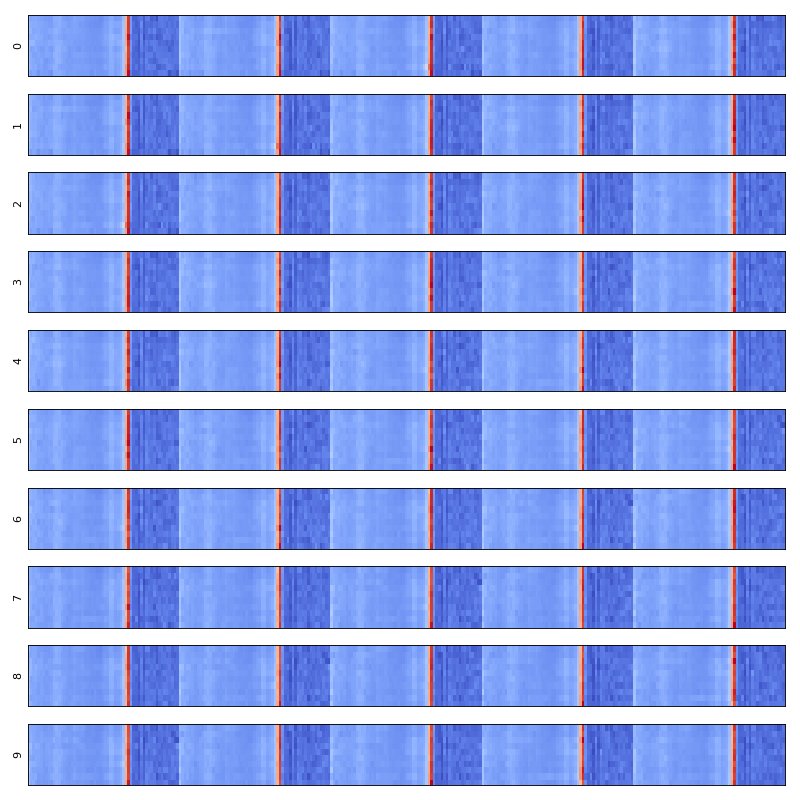
Handling multi-channel audio and output data in 4D matrix:
# Define processing chain
chain = dcase_util.processors.ProcessingChain([
{
'processor_name': 'AudioReadingProcessor',
'init_parameters': {
'fs': 44100
}
},
{
'processor_name': 'RepositoryFeatureExtractorProcessor',
'init_parameters': {
'parameters': {
'mel': {}
}
}
},
{
'processor_name': 'RepositorySequencingProcessor',
'init_parameters': {
'sequence_length': 100
}
},
{
'processor_name': 'RepositoryToMatrixProcessor',
'init_parameters': {
'label': 'mel',
'expanded_dimension': 'last'
}
},
])
# Run the processing chain
data = chain.process(filename=dcase_util.utils.Example().audio_filename())
data.show()
data.plot()
# DataMatrix4DContainer :: Class
# Data
# data : matrix (40,100,5,2)
# Dimensions
# time_axis : 1
# Timing information
# time_resolution : None
# Meta
# stats : Calculated
# metadata : -
# processing_chain : -
# Duration
# Frames : 20
# Data
# Dimensions
# time_axis : 1
# data_axis : 0
# sequence_axis : 2
# Data
# Dimensions
# time_axis : 1
# data_axis : 0
# sequence_axis : 2
# channel_axis : 3
(Source code, png, hires.png, pdf)
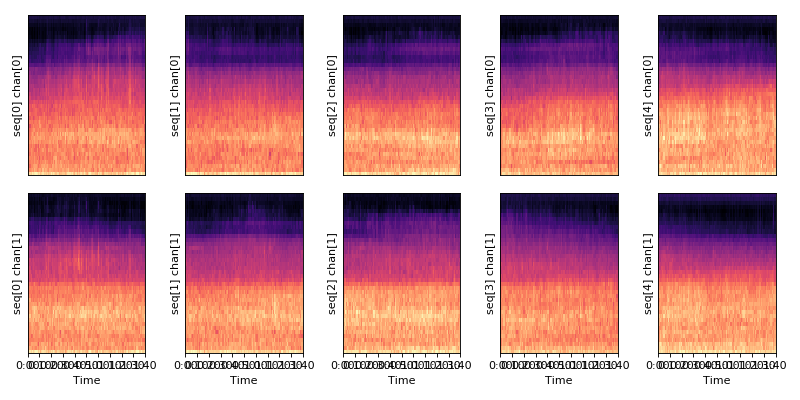
Meta data processing
Getting event roll:
import tempfile
tmp = tempfile.NamedTemporaryFile('r+', suffix='.txt', delete=False)
dcase_util.utils.Example.event_metadata_container().save(filename=tmp.name)
# Define processing chain
chain = dcase_util.processors.ProcessingChain([
{
'processor_name': 'dcase_util.processors.MetadataReadingProcessor',
'init_parameters': {}
},
{
'processor_name': 'dcase_util.processors.EventRollEncodingProcessor',
'init_parameters': {
'label_list': dcase_util.utils.Example.event_metadata_container().unique_event_labels,
'time_resolution': 0.02,
}
}
])
# Do the processing
data = chain.process(
filename=tmp.name,
focus_filename='test1.wav'
)
# Plot data
data.plot()
(Source code, png, hires.png, pdf)

Getting event roll for focus segment:
import tempfile
tmp = tempfile.NamedTemporaryFile('r+', suffix='.txt', delete=False)
dcase_util.utils.Example.event_metadata_container().save(filename=tmp.name)
# Define processing chain
chain = dcase_util.processors.ProcessingChain([
{
'processor_name': 'dcase_util.processors.MetadataReadingProcessor',
'init_parameters': {}
},
{
'processor_name': 'dcase_util.processors.EventRollEncodingProcessor',
'init_parameters': {
'label_list': dcase_util.utils.Example.event_metadata_container().unique_event_labels,
'time_resolution': 0.02,
}
}
])
# Do the processing
data = chain.process(
filename=tmp.name,
focus_filename='test1.wav',
focus_start_seconds=2.0,
focus_stop_seconds=6.5,
)
# Plot data
data.plot()
(Source code, png, hires.png, pdf)
